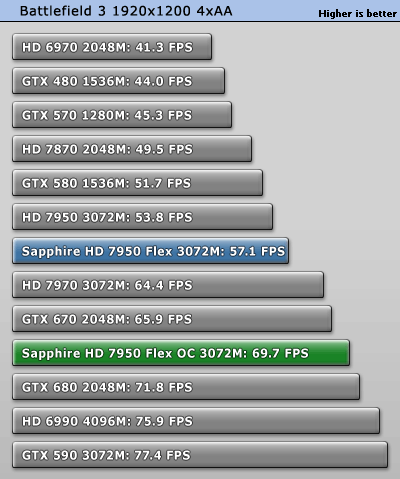What AMD ships to reviewers for a bios for testing/reviews is not misleading. Repeating nonsense about what you consider real world information based upon unconfirmed stable or not stable overclocks is misleading and ridiculous.
I disagree. You implying that 1.25V is the average for 7950 card is a number you pulled out of thin air to justify your viewpoint that 7950 is hot, loud and power hungry. You conveniently ignored all these cards that have quiet coolers, which do not run hot and none of them comes with 1.25V bios.
1)
Gigabyte Windforce 3x - $318
2) S
apphire 950mhz Dual-X 7950 - $318
3)
PowerColor PCS+ 7950 = $338
4)
HIS IceQ 7950 = $330
5)
MSI TF3 880mhz 7950 = $318
6)
Sapphire Vapor-X 950mhz 7950 = $338
If you read the reviews, most of these cards overclock to 1100-1150mhz on 1.175V or below (*except the Vapor-X that comes with 1.212V I believe). While the Vapor-X comes with higher voltages, the cooling system on it can keep a
1200mhz 7970 TOXIC below 70*C. That card is built like a tank, with 9 premium black diamond chokes from the $700 TOXIC that guarantee no coil whine. Please let me know when I can buy a GTX660Ti with such premium quality parts and a cooler to match.
You keep downplaying overclocking on the 7950 and implying that 1.25V is the real average that would push the power consumption of the 7950 into some stratosphere level. Yet, I heard none of these things from you when GTX460 @ 850-925mhz dominated AMD from a price/performance viewpoint. That's right, GTX460 became one of the best cards because of its overclocking despite the power consumption for such a card rising exponentially in the process and as usual overclocking not being guaranteed.
Now that 7950 completely mops the floor with the 660Ti, all of that is mysteriously forgotten.
vs. just a 1.03ghz 7950 already comes close to a stock 680 for
$180 less! And this is in one of the best games for GK104.
I see so when GTX460 delivered HD5870 level of performance at OCed speeds for less $, performance/watt was disregarded. Yet, when an 1150mhz HD7950 passes GTX680/HD7970GE and provides GTX670 OC performance for $60-80 less, suddenly performance/watt is THE most important metric, above performance, price/performance, compute features, bitcoin mining, 3GB of VRAM for mods, above everything really. You seem to be focusing on performance/watt so much actually, that I am amazed you even bought GTX460s yourself, and didn't have any problems with GTX470/480/570/580 cards from a performance/watt metric when they got dominated by 5850 OC/5870/6950 2GB in very same metric you deem as suddenly the most important. Back then performance was more important than performance/watt? So why aren't you touting 7950 OC's performance advantage over the 660Ti's OC in light of all these historical factors? :hmm:
My story is I recommend cards on price/performance and consider OCing as a bonus that can often save gamers $. Your story seems to be changing between top performance (Fermi, bonus more VRAM) to performance/watt (GK104) to overclocking should be a factor (GTX460 @ 875mhz SLI in your own system) depending on which of these puts NV in the lead.
This round 7950 OC provides better price/performance and overall performance than a 660Ti OC and 7870 provides better price/performance, but you are saying performance/watt should now be the deciding factor and overclocking is no longer a factor? Which is it?
You did buy GTX460 over the 5850, right? I see....a GTX460 @
900mhz uses > 200W of power; and you have
2 of those! You've been criticizing the entire HD7950/7970 generation's performance/watt non-stop and your own card sucks power that is equivalent to a
1150-1200mhz HD7970!!!!!!!!!!!!!!!
vs.
From where I am looking an HD7970 @ 1200mhz
beats a GTX590 and uses maybe 20W more power than 1 of your cards. Correct me if I am wrong but that would put HD7970 @ 1.15-1.2ghz at nearly twice the performance/watt of your GTX460 @ 875mhz SLI setup. The GTX680 is what 25% more efficient but costs $100 more than a good
after-market 7970?
=======================
You still have not addressed why someone should spend $60-80 more for a GTX660Ti over the 7870. 10% more performance for 25-35% price increase.










